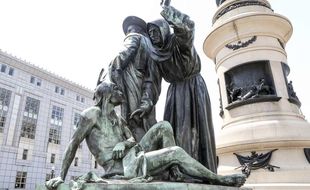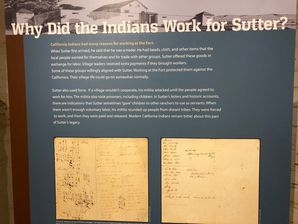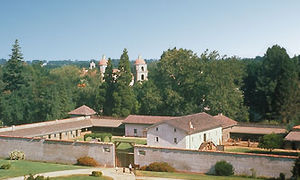Beyond Basketry: Native American Memorialization and the California Gold Rush
An Ignored History
The history of California as a state in the Union is anchored in the discovery of gold in 1849 and the subsequent Gold Rush that brought immigrants from around the wold in search of their fortunes. State memorials to this history are filtered through the lens of white American and European settlers, a narrative that ignores the indigenous people of California (Trafzer). The Native Americans of California were still very much alive and their labor was integral to the foundation and success of the Gold Rush (OPH). Additionally, memorials to California Indians focus on their existence prior to Spanish invasion and ignores the impact of the Gold Rush and statehood while glorifying the major white figures in settlement (Dartt-Newton).
The long battle over a statue in the center of San Francisco encapsulates this struggle. The San Francisco John Lick Pioneer Monument features statues and plaques commemorating California history. One statue - of a Spanish Missionary and Mexicano Vaquero standing over a fallen California Indian - has been the focus of a decades long effort to have the statue removed, led by the California Indians (Blei).
California Indian Memorialialization: Museum Exhibitions
After the arrival of the Spanish and the imposition of the Mission system in the 17th-century, the California Indian population dropped from approximately 310,000 to 100,000 in less than 100 years (OPH). After the Mexican defeat of the Spanish in 1891, Mexico issued land grants to Mexicano's and naturalized citizens, such as Swiss immigrant John Sutter, who received 49,000 acres and established a fort built with Indian labor (OPH, NPS). Sutter's example is perfectly in keeping with the treatment the Indians faced under Mexican rule; but when California was seceded to the United States by Mexico under the 1848 Treaty of Guadalupe Hidalgo, things became decidedly worse.
Memorials to and exhibits about the California Indians heavily focus on their existence prior to colonization (Dartt-Newton), a narrative built around a utopic existence where they lived off of and in harmony with the land, isolated from and uncomplicated by external strife. Attention is paid to the catastrophic effect of Spanish inflicted atrocities, but typically skim lightly from the end of the Missions to the modern day - if that (Dartt-Newton).
Displays showcase the following - examples pulled from the State Indian Museum, established in 1940 and updated in 1986, are nearly identical across the state:
- Basketry
- Ceramic vessels
- Land and resource management
- Hunting and gathering practices
- Cooking - especially that of acorns
- Clothing and ceremonial dress
- Ceremonial and spiritual practices
- Architecture
- Trade
The Donner Party and Lewis & Salvador
The story of the Donner Party - one of the most sordid tales in California history - is a memorable example of the lack of California Indian representation in memorialization.
A wagon train that chose not to follow the Oregon Trail, the Donner party became trapped in the Sierra Nevada during one of the worst recorded winters. Trapped for months in snow drifts up to 23 feet deep, starvation set in. Potential rescue arrived in the form of Charlie Stanton, a party member who had gone ahead. He returned with two California Indian men called Lewis and Salvador, assigned to the rescue by John Sutter. As the rescue party and those physically capable capable attempted the trek out, Stanton and others succumbed to the elements and died. Mired in the snow, the living resorted to cannibalism to survive. When no other natural deaths occurred, the pioneers murdered Lewis and Salvador for their flesh.
As the snows melted and the remaining members were rescued, attempts were made to erase all evidence of the events, but the story spread and became a salacious part of California history.
At the site of the cabins used by the party in the Sierras, a monument was erected to memorialize the party and other emigrants. In the 20th-century, the area became a state park with a museum. The museum exhibits trace the history of the Oregon Trail and California emigration and includes an exhibit on the California Indians prior to white settlement. Yet only once are Lewis and Salvador mentioned, included in the list of party members. While they are listed among the deceased, I noted that no mention of their murder is included, nor is it acknowledged that they were not part of the original wagon train. (Donner Memorial SP)
The Donner Party story remains a point of lurid fascination in California, yet even this most distasteful of tales utterly fails to address the toll paid by the Native Americans.
Indian Slavery and John Sutter
The Gold Rush forever changed the history of California. Bringing immigrants from around the world, the white population skyrocketed from around 15,000 to around 300,000 within a few years thanks to the influx of prospectors and those aiming to make a profit or find an uncontested place to settle (Starr). Towns and cities sprang up, and agriculture and farmsteads were established to support the need for food and goods (Magliari). White settlers turned to the remaining California Indians to fill the need for labor. Used largely for ranch or domestic work, the Indians were relegated to slave status, largely thanks to the Indian Act of 1850, which established laws to govern the natives (OPH). These laws were highly reminiscent of the Antebellum Black Codes of the North, criminalizing the act of existence and sentencing those who broke it to indentured servitude in a white household. Vagrancy and lack of employment were among the criminalized behaviors, and the law also remanded native children to white caretakers (OPH). The law in no way provided protections for the Indians, and also instituted the creation of reservations. As cheap labor became more readily available with the continued influx of immigrants, and the Indians with confined to poorly maintained reservations where thousands died from starvation, lack of shelter or clean water, disease (Magliari).
The embodiment of this system is undeniably John Sutter, considered one of the great pioneers in California history. After securing his 49,000 acre land grant from Mexico, Sutter - using Indian labor - built a fort designed as plantation house, homestead, and trading post or waystation for arriving pioneers (Magliari). Sutter made deals with the Indian tribes in his immediate vicinity, the Miwok and Maidu, exchanging goods and land for labor. When this was not enough, Sutter turned to less than scrupulous means, kidnapping women and children to serve as domestic work and killing or enslaving able bodied men. Using their labor, Sutter practiced agriculture and ranching, providing little shelter or sustenance - even feeding them from troughs. Southerners visiting remarked on the likeness to Southern slave plantations. (Starr)
Sutter's Fort is now an immensely popular state park in Old Town Sacramento, a small riverside section of the state capital where visitors can walk along wooden walkways, the railroad history museum, and Sutter's Fort State Park. After Sutter's death, the dilapidated fort was partially rebuild as a memorial, and during the 20th century, it was expanded upon to create a replica of the fort as it once stood (Sutter's Fort). At this state park, visitors can experience living history through exhibits and reenactors (Sutter's Fort). The park is devoted to showcasing life as it was during the beginnings of the state, but little space is reserved to include the California Indians that lived and died working for Sutter. In the last decade, an effort has been made to rectify this in some small way, and new exhibition panels offer a harsher, more realistic representation of that history.
Sutter, John Marshall, and the Discovery of Gold
One of the men John Sutter partnered with was John Marshall. Marshall approached Sutter seeking aid in building a mill. It was agreed that Sutter would provide the labor and Marshall would provide the knowhow. Sutter gave Marshall Indians workers to begin building the mill (Marshall Gold SP). Once erected and functional it was maintained and run by Indian laborers under the oversight of white men. One day while monitoring the mill, workers found glimmering yellow flecks of metal in the sluice. Sutter confirmed that the find was gold, word spread, and the Gold Rush began (OPH). Today, Sutter's Mill is a part of the Gold Discovery State Historical Park. This park incorporates Sutter's Mill and a monument to John Marshall, and acts as a living history museum, with reenactors playing the parts of the white people involved in the Gold Rush. Visitors can view live exhibitions of pioneer life, and even pan for gold (Marshall Gold SP). Nowhere in this park is there a mention of the Native American labor involved in the discovery of the gold and the workings of the Gold Rush. A small section displays the usual Indian artifacts, and gives lip service to their lives before the Spanish, but gives no indication of their existence past the fall of the Missions. (OHP, Marshall Gold SP)
California Indian Memorialization: An Unmarked Field
California Historical Landmark Number 900 may as well not exist. Marking the spot where the Nisipowinian people - a subset of the Maidu tribe - lived, the site is located outside of the reconstructed fort in Sutter's Fort SHP, this unmarked field has no plaque, memorial, or evidence of those who lived or are buried there. Save for the inclusion of the site - at the end of the archery range, with an incorrect spelling of the tribe name - as a registered California State Historical Landmark, one would never know that this was a site of historical interest or prior civilization. (Schmidt)
The Potential for Change
The question over how to include California Indian history is an ongoing debate in California. California Indian tribes object strongly to the deification of the Missions - few of which mention or make clear the contributions of and price paid by the Indians. Discussions about the need to include a thorough address of California Indian history in memorials, research, and in academic discourse and education (Magliari, Trafzer).
The question continues into depictions of the Gold Rush, and how white migration is lauded and mythologized while other groups are marginalized or removed entirely from the narrative. Books such as An American Genocide, by Benjamin Madly, address the genocide of the California Indians and the legacy of their descendants (Trafzer). Strident protest against the Missions by California Indians continues (Seipel). A push for more accurate educational materials, such as textbooks and a possible elimination of the California elementary school required 4th grade "Missions Project" is garnering notice (Magliari). Sutter's Fort has added exhibit text addressing the immoral, violent actions taken by Sutter and the pioneers against the Indians (Sutter's Fort SP). A new center dedicated to California Indian Heritage is being built in Sacramento with oversight by California Indian leaders and academics with the goal of properly commemorating and championing Indian history of culture (CIHC). And in San Francisco, a decision was finally made in the debate over the "Early Days" statue ended when, in fall of 2018, the statue was removed and remanded to storage (Blei). The broader issue remains, but this speaks to the possibility of further change.
Work Cited
California Indian Heritage Center. California State Parks. State of California, 2019. Accessed 25 March 2019. parks.ca.gov/?page_id=22628
Dartt‐Newton, D. (2011), CALIFORNIA'S SITES OF CONSCIENCE: An Analysis of the State's Historic Mission Museums. Museum Anthropology, 34: 97-108. doi:10.1111/j.1548-1379.2011.01111.x
Donner Memorial State Park. California Department of Parks and Recreation, California State Parks. State of California, 2019. Accessed 25 March 2019. parks.ca.gov/?page_id=503
Dutschke, Dwight. Five Views: An Ethnic Historic Site Survey for California. National Park Service, 17 November 2004. Accessed 25 March 2019. nps.gov/parkhistory/online_books/5views/5views1h90.htm
Magliari, Michael F. "Free State Slavery: Bound Indian Labor and Slave Trafficking in California's Sacramento Valley, 1850–1864." Pacific Historical Review 81, no. 2 (2012): 155-92. doi:10.1525/phr.2012.81.2.155.
Marshall Gold Discovery State Historical Park. California Department of Parks and Recreation, California State Parks. State of California, 2019. Accessed 25 March 2019. parks.ca.gov/?page_id=484
Schmidt, David. "California Historical Landmark 900". landmarkquest.com, 2009. Accessed 25 March, 2019. landmarkquest.com/sacramento/chl900.htm
Starr, Kevin. “The Gold Rush and the California Dream.” California History, vol. 77, no. 1, 1998, pp. 56–67. JSTOR, jstor.org/stable/25462462.
Sutter’s Fort State Historic Park. California Department of Parks and Recreation, California State Parks. State of California, 2019. Accessed 25 March 2019. parks.ca.gov/?page_id=21507
Trafzer, Clifford E, Michelle Lorimer. “Silencing California Indian Genocide in Social Studies Texts.” American Behavioral Scientist. 58 Issue 1 (2014): 64-82, accessed 25 March 2019, doi/full/10.1177/0002764213495032























